My home data center
This is not another article about how some "economy" decided to put the server in his apartment and host the website at home, because he mistakenly thought that it would be cheaper than in the data center. Without power and channel redundancy, without creating the necessary climatic environment for the operation of server equipment. With huge electricity bills and a disgruntled Internet provider who did not subscribe to supply the channel for "100 rubles" for a server or server rack :)
No, this is an article about quite real working mini data centers at home, created by enthusiasts and IT specialists who want to be “closer to the equipment”, who began to place not just servers, but racks with servers and organize quite interesting test environments. Often, such solutions, equipped in garages, basements of their own homes and even home offices, require upgrading the power supply system and network connection. The article deals with cases that really deserve attention.
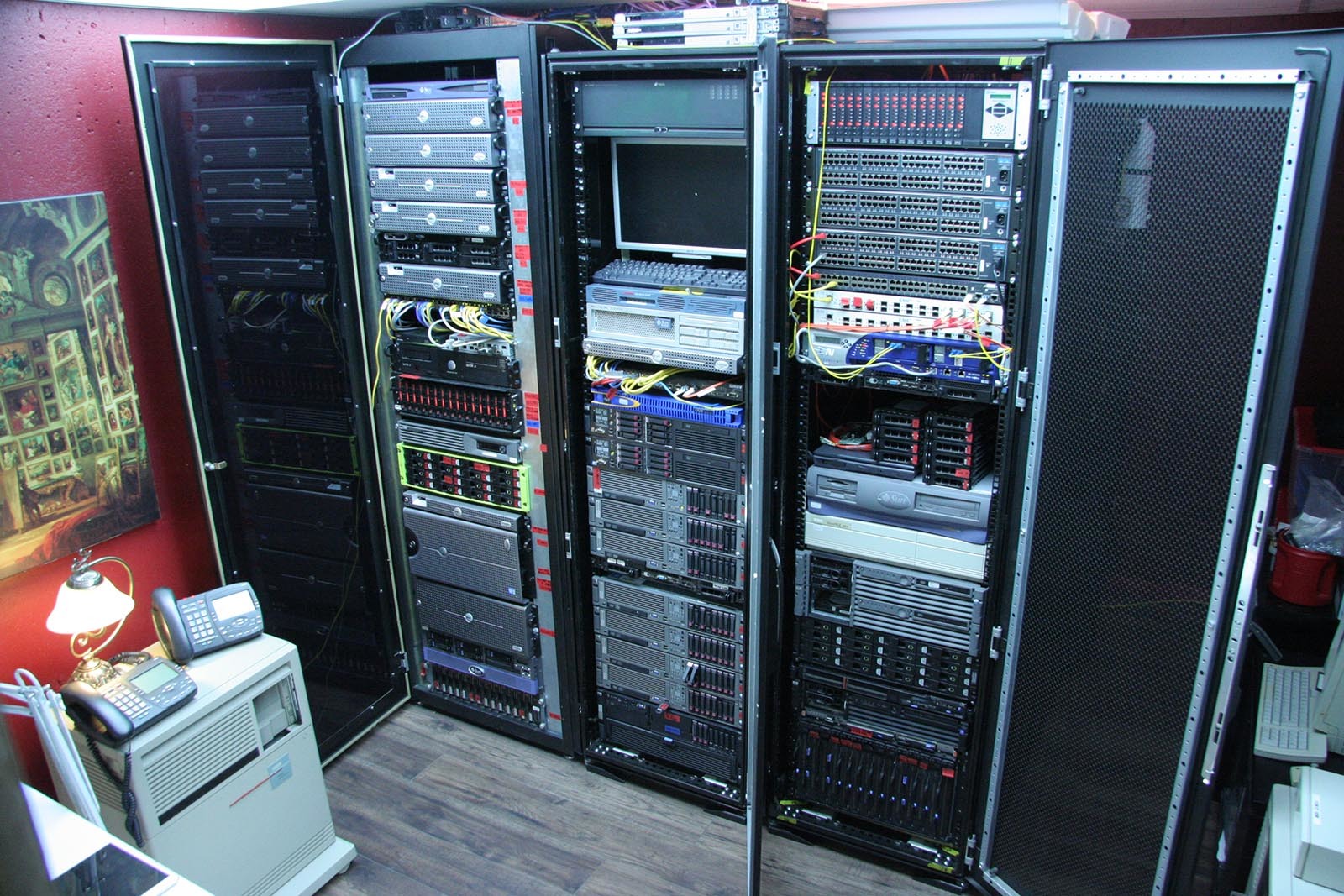
')
And the first of them, and perhaps the most worthy one, is the home data center of the ve2cuy project, organized by Canadian IT specialist Alain Boundreault at home, not so much with the goal of saving as with the goal of implementing various custom-built solutions, improving your own skills, well, just because it was interesting to him and he could. My opinion is very cool, a good workshop, not always such infrastructures can be so thought out in real data centers. And in addition, it is a truly economically efficient solution that fully satisfies the needs of its creator. Let's get to know him? Alain Boundreault has already become famous on YouTube and recently posted a video tour of his home data center, evaluate his work for yourself:
It is clear that Alain is not the only one who builds such solutions at home. But the uniqueness of the ve2cuy project is that Alain used, although outdated, but exclusively high-end equipment from Dell, HP, Sun, Juniper and IBM, upgraded the power grid, provided the climate and placed it all in the basement of their own home, including high-end computing equipment. density, such as the IBM BladeCenter.
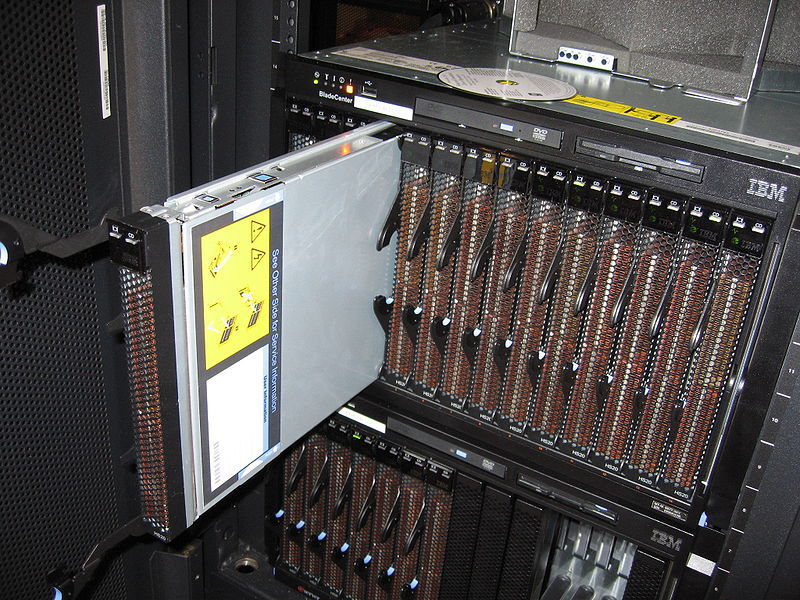
On his website you can find a detailed overview of the solution built, including a diagram of all the components, including the Open Stack MAAS (Metal as a Service) cloud and many storage systems (iSCSI and Fiber Channel).
“My first step was the improvement of the power grid, the installation of an electrical panel that allows 40 amps at 240 volts or 9.6 kW of power. Servers are rarely loaded at the same time, because actual energy consumption is often only 1-2 kWh, at a cost of electricity in Quebec about 7 cents per kWh, which provides high economic efficiency, ”says Boudreault, who teaches software development and uses solution including for these purposes. Nevertheless, he notes that his type of home data center is "not for the faint of heart."
And the author understands this. For the question of why he did not post the web page of his own project on a solution built at home, Alain replied: “I used to host ve2cuy one of my home servers earlier, but living in rural areas, we are exposed to too many power failures. The power of the UPS installed in my data center will last no more than 20 minutes. In addition, my provider blocks port 80, which made the task rather complicated. Thank you for your question. PS I have a working copy of the site on one of the servers at home, perhaps, one day, I will put it back into working mode. ”
By the way, with the Internet provider, I had a problem not only with Alain, but also with our next participant, who is known by the nickname houkouonchi, who installed only 1 server cabinet at home and received more than 350,000 YouTube views since 2012:
In fact, this is “not a real data center, but not in many houses there is a full-size server cabinet with more than 150 TB storage in it,” writes houkouonchi. “This cabinet is bolted through a wooden floor directly to the cement foundation. A fully populated rack consumes about one kWh of power. ”
In 2013, he was contacted by his Verizon Internet provider, who was quite surprised to see more than 50 terabytes of traffic per month from a client with a home-use tariff plan. It turned out that the placement of media servers violates the terms of service for home users and houkouonchi had to switch to a tariff plan for business subscribers.
It is also worth noting an interesting explanation houkouonchi, about why in his servers at home there are no Seagate drives:
“Servers come with Seagate disks, we replace them with Hitachi, since almost all the disks you see in the video are failed disks in a batch of 100 servers.”
Why use a standard server cabinet from the data center at home if you can use a stylish table made of IKEA? Enthusiasts from the Netherlands came up with this when they found that the Swedish tables LACK, have a space between the legs of exactly 19 inches, the same width as the slot of the server rack in the data center, which means you can mount switches and servers!
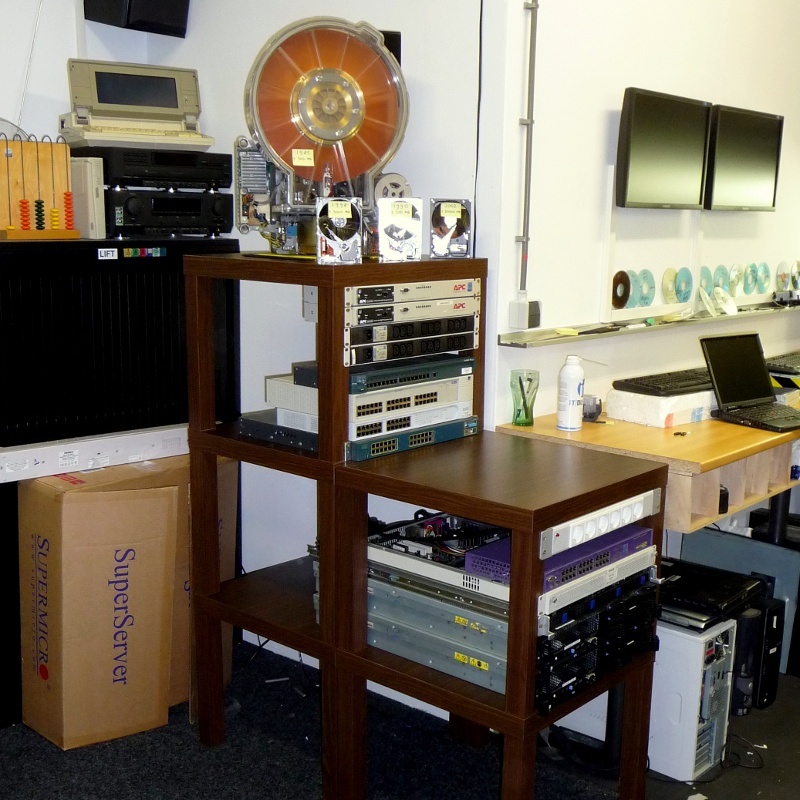
This seemingly comic idea received a rather rapid development, this was how the project LACKRack was created. Server space is created using screws and mounting angles that are mounted on the legs of the table. The number of tables can be increased in a modular fashion, so that solutions can be assembled in various configurations. Even the assembly instructions were released.
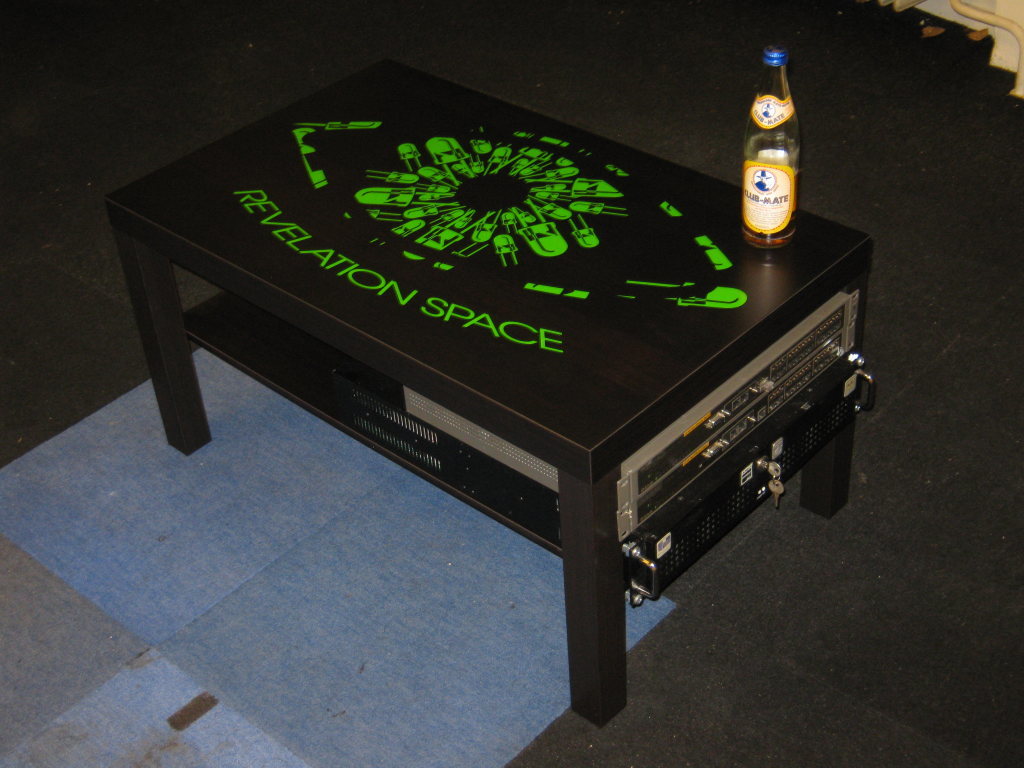
Since its first appearance in 2010, LACKRack was transformed in design and even acquired modifications. Technological evangelist Frank Dennemen from PernixData in his article about the new, mobile version of LACKRack, modified by him, noted that sometimes he wants to break something or kill the entire server to see what will happen, and for this purpose he really needs a home laboratory, as well as, 19-inch standard cabinets do not fit into the design of modern interiors, it is useful to have something like LACKRack, only with wheels, to be able to comfortably move around the house. The result can be seen below:
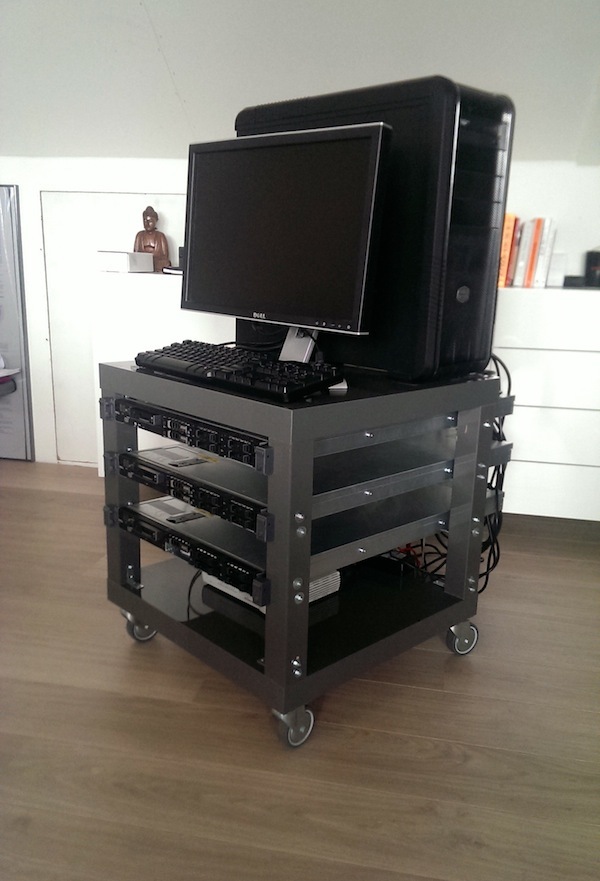
The organization of home laboratories and data centers for the purpose of application testing and development is becoming increasingly popular, now on the Internet you can find worthy vlogs on this topic, one of the memorable ones is the GNET Data Center Project , however even more projects remain hidden from the public . Maybe you organized your home mini data center, or do you know some other worthy project? Share it in the comments.
Well, and for those who wish to receive a virtual test (or working) environment from our company free of charge until the end of winter , we provide this opportunity - leave in the comments the order number of any virtual server with dedicated drives in the Netherlands :








And we will provide you with January + February for free , and the payment already made will be taken into account as payment for March, we also guarantee a refund for any reason, until the end of this month, if the service does not suit you. The promotion is valid only for registered Habr readers who can leave a comment on this article, which means no more than 10 days from the date of publication in order to take part in the promotion if you have not left a single comment here before.
The commentator who left the most useful comment on the topic of the article and received the greatest number of pluses over the next 7 days has the right to request a full-featured dedicated server in the Netherlands 2 x Intel Dodeca-Core Xeon E5-2650 v4 / 128GB DDR4 / 6x480GB SSD / 1Gbps 100 TV to the end of winter is free, subject to payment for services for the month of March.
No, this is an article about quite real working mini data centers at home, created by enthusiasts and IT specialists who want to be “closer to the equipment”, who began to place not just servers, but racks with servers and organize quite interesting test environments. Often, such solutions, equipped in garages, basements of their own homes and even home offices, require upgrading the power supply system and network connection. The article deals with cases that really deserve attention.

')
And the first of them, and perhaps the most worthy one, is the home data center of the ve2cuy project, organized by Canadian IT specialist Alain Boundreault at home, not so much with the goal of saving as with the goal of implementing various custom-built solutions, improving your own skills, well, just because it was interesting to him and he could. My opinion is very cool, a good workshop, not always such infrastructures can be so thought out in real data centers. And in addition, it is a truly economically efficient solution that fully satisfies the needs of its creator. Let's get to know him? Alain Boundreault has already become famous on YouTube and recently posted a video tour of his home data center, evaluate his work for yourself:
It is clear that Alain is not the only one who builds such solutions at home. But the uniqueness of the ve2cuy project is that Alain used, although outdated, but exclusively high-end equipment from Dell, HP, Sun, Juniper and IBM, upgraded the power grid, provided the climate and placed it all in the basement of their own home, including high-end computing equipment. density, such as the IBM BladeCenter.

On his website you can find a detailed overview of the solution built, including a diagram of all the components, including the Open Stack MAAS (Metal as a Service) cloud and many storage systems (iSCSI and Fiber Channel).
“My first step was the improvement of the power grid, the installation of an electrical panel that allows 40 amps at 240 volts or 9.6 kW of power. Servers are rarely loaded at the same time, because actual energy consumption is often only 1-2 kWh, at a cost of electricity in Quebec about 7 cents per kWh, which provides high economic efficiency, ”says Boudreault, who teaches software development and uses solution including for these purposes. Nevertheless, he notes that his type of home data center is "not for the faint of heart."
And the author understands this. For the question of why he did not post the web page of his own project on a solution built at home, Alain replied: “I used to host ve2cuy one of my home servers earlier, but living in rural areas, we are exposed to too many power failures. The power of the UPS installed in my data center will last no more than 20 minutes. In addition, my provider blocks port 80, which made the task rather complicated. Thank you for your question. PS I have a working copy of the site on one of the servers at home, perhaps, one day, I will put it back into working mode. ”
By the way, with the Internet provider, I had a problem not only with Alain, but also with our next participant, who is known by the nickname houkouonchi, who installed only 1 server cabinet at home and received more than 350,000 YouTube views since 2012:
In fact, this is “not a real data center, but not in many houses there is a full-size server cabinet with more than 150 TB storage in it,” writes houkouonchi. “This cabinet is bolted through a wooden floor directly to the cement foundation. A fully populated rack consumes about one kWh of power. ”
In 2013, he was contacted by his Verizon Internet provider, who was quite surprised to see more than 50 terabytes of traffic per month from a client with a home-use tariff plan. It turned out that the placement of media servers violates the terms of service for home users and houkouonchi had to switch to a tariff plan for business subscribers.
It is also worth noting an interesting explanation houkouonchi, about why in his servers at home there are no Seagate drives:
“Servers come with Seagate disks, we replace them with Hitachi, since almost all the disks you see in the video are failed disks in a batch of 100 servers.”
Server cabinet from IKEA?
Why use a standard server cabinet from the data center at home if you can use a stylish table made of IKEA? Enthusiasts from the Netherlands came up with this when they found that the Swedish tables LACK, have a space between the legs of exactly 19 inches, the same width as the slot of the server rack in the data center, which means you can mount switches and servers!

This seemingly comic idea received a rather rapid development, this was how the project LACKRack was created. Server space is created using screws and mounting angles that are mounted on the legs of the table. The number of tables can be increased in a modular fashion, so that solutions can be assembled in various configurations. Even the assembly instructions were released.

Since its first appearance in 2010, LACKRack was transformed in design and even acquired modifications. Technological evangelist Frank Dennemen from PernixData in his article about the new, mobile version of LACKRack, modified by him, noted that sometimes he wants to break something or kill the entire server to see what will happen, and for this purpose he really needs a home laboratory, as well as, 19-inch standard cabinets do not fit into the design of modern interiors, it is useful to have something like LACKRack, only with wheels, to be able to comfortably move around the house. The result can be seen below:

The organization of home laboratories and data centers for the purpose of application testing and development is becoming increasingly popular, now on the Internet you can find worthy vlogs on this topic, one of the memorable ones is the GNET Data Center Project , however even more projects remain hidden from the public . Maybe you organized your home mini data center, or do you know some other worthy project? Share it in the comments.
Well, and for those who wish to receive a virtual test (or working) environment from our company free of charge until the end of winter , we provide this opportunity - leave in the comments the order number of any virtual server with dedicated drives in the Netherlands :








And we will provide you with January + February for free , and the payment already made will be taken into account as payment for March, we also guarantee a refund for any reason, until the end of this month, if the service does not suit you. The promotion is valid only for registered Habr readers who can leave a comment on this article, which means no more than 10 days from the date of publication in order to take part in the promotion if you have not left a single comment here before.
The commentator who left the most useful comment on the topic of the article and received the greatest number of pluses over the next 7 days has the right to request a full-featured dedicated server in the Netherlands 2 x Intel Dodeca-Core Xeon E5-2650 v4 / 128GB DDR4 / 6x480GB SSD / 1Gbps 100 TV to the end of winter is free, subject to payment for services for the month of March.
Source: https://habr.com/ru/post/319516/
All Articles